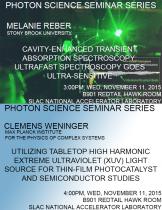Speaker: Clemens Weninger, Max Planck Institute for the Physics of Complex Systems
Program Description
The recent advance of x-ray free electron lasers (XFELs) allows to investigate non-linear processes in the x-ray domain for the first time. Nonlinear spectroscopy in the x-ray domain is a promising technique to explore the dynamics of elementary excitations in matter.
Focusing an intense XFEL pulse into a dense target produces a population inversion between the inner-shell orbitals and the valence orbitals. The spontaneous emission emitted in forward direction stimulates the x-ray emission along the medium and generates a highly directional and intense x-ray laser pulse. The stimulation amplifies the x-ray emission by several orders of magnitude and confines the emission into a small solid angle. This significantly reduces the required measurement time and allows to measure single-shot x-ray emission spectra. This talk presents a one-dimensional Maxwell-Bloch model to describe stimulated emission from atoms. The numerical simulations reveal that the short lifetime of the upper lasing state leads to unexpected pulse properties during the amplification.
Resonantly exciting a dense gas target with high-intensity broadband x-ray pulses leads to the generation of a stimulated inelastic x-ray scattering signal. This talk will present the first experimental demonstration of stimulated x-ray Raman scattering along with a theoretical modeling of the scattering process. The incoherent XFEL pulses lead to a stochastic line shift of the inelastically scattered radiation. With the help of statistical methods a spectral resolution of the scattering process beyond the natural lifetime of the core-excited state can be obtained.
In the outlook I will present recent results from LCLS on stimulated x-ray emission from transition metal complexes in solution. We were able to detect stimulated emission spectra with a bandwidth below the natural width and confirmed that the chemical information is preserved in the stimulated x-ray emission.





